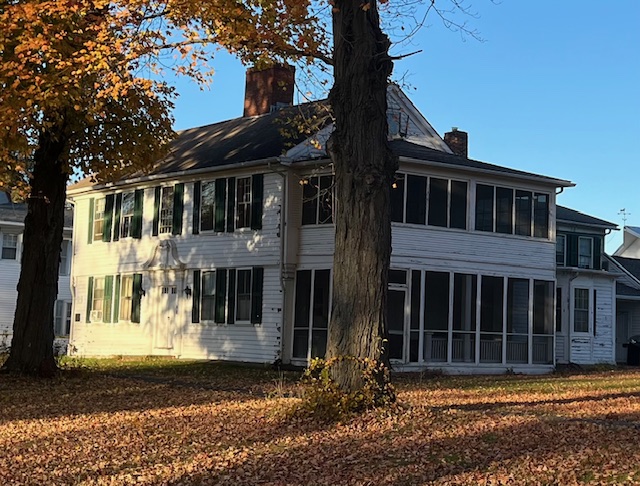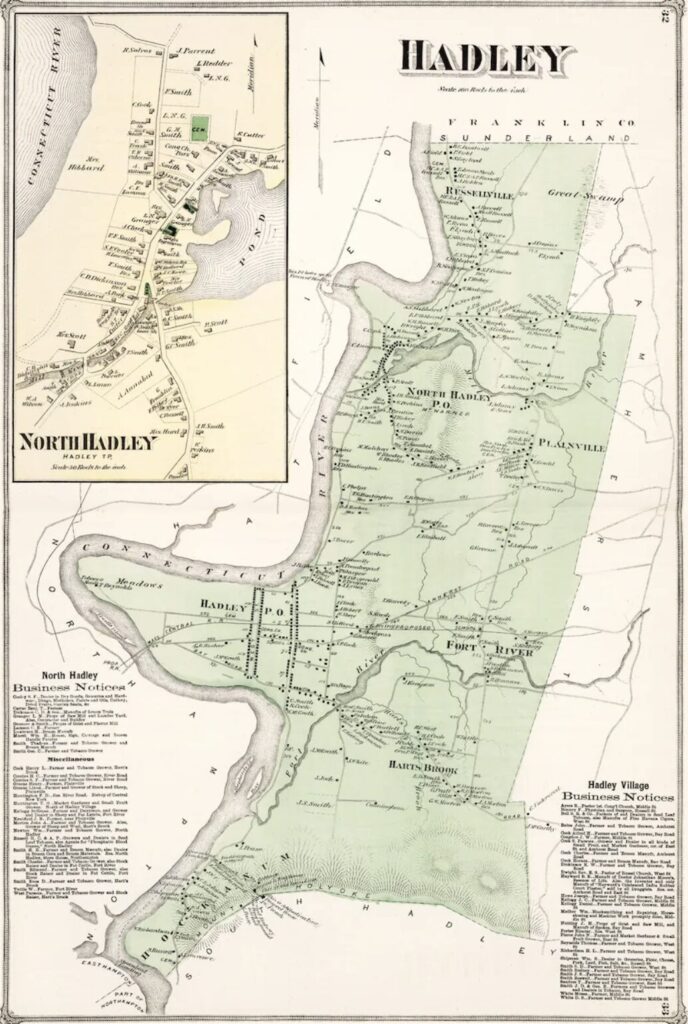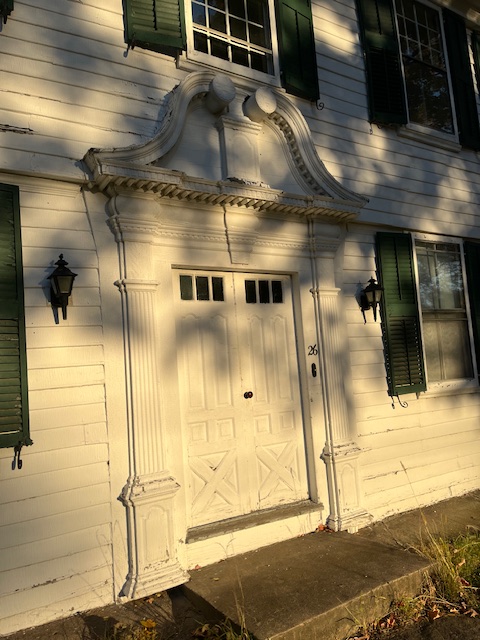Amherst’s Neighboring Towns: Hadley, Amherst’s Mother Town

The Samuel Porter House (1713) in Hadley. Photo: Hetty Startup
Amherst History Month by Month
This column is the fourth in a 10-part series about towns surrounding Amherst. Previous columns covered Pelham, Shutesbury, and Sunderland. For a listing of all previous “Amherst History Month by Month” columns, look here.
Hadley borders Amherst to the west and, to me, is best represented by the tongue-shaped stretch of land formed by a distinct curve in the Connecticut River that separates the east and west sides of the Valley.

A portion of this pastoral heartland is lined by a dike, echoed by one on the other side of the river by the Calvin Coolidge Bridge. Each dike protects the most arrestingly beautiful meadowlands we have in the region; and it comes as no surprise that these places were the homesites of Nipmuc and Norwottuck before colonial settlement took place. The Hadley Dike is always populated these days by walkers and/or photographers. Just to the east of the dike is Hadley’s colonial-era town center, laid out on West, East, and Middle Streets (crossing Route 9). Near this civic part of town is the oldest house on West Street, the Samuel Porter House (1713); its splendid front door, added in about 1761, a door that is recalled in the front entrance of the Jones Library in Amherst and in other examples of Colonial and Colonial Revival doorways exhibited at Historic Deerfield


Each spring, a stone’s throw from here, you can enjoy the annual Asparagus Festival, asparagus being grown so successfully here that it is known locally as “Hadley grass.” Hadley’s secondary school, Hopkins Academy, founded in 1664, is near the intersection of Routes 9 and 47, as are the Congregational church and town hall. Recently completed near this location are the new library and senior center. According to the organization Amherst Neighbors, the Hadley Senior Center, located at 46 Middle Street, has a medical equipment lending room that includes items such as wheelchairs, walkers, rollators, shower benches, commodes, and more. The equipment is available to Amherst as well as Hadley residents.
Also at the intersection of Routes 9 and 47 is the very cool Hadley Farm Museum, now closed for the season but open annually from May through October. The museum, founded in 1931 by brothers Henry R. and C.J. Johnson, is housed in a restored 1782 barn that was moved from the Porter-Phelps-Huntington estate north on Route 47 in the 40 Acres and its Skirts historic district.
It is from the vantage point of the historic Phelps house (1752) that other histories of Hadley can be brought to light. One aspect of the colonial story, obscured until recently, concerns the use of enslaved labor on the Phelps farm. The names of individuals who were enslaved there — “Zebulon Prutt, Cesar Phelps, Peg Bowen, her daughters Rose and Phillis, and granddaughter Phillis” — are now recorded in promotional, programmatic and interpretive source materials at the Porter-Phelps-Huntington house.
A deeper historic record is alluded to in the nomination of the North Hadley Historic District to the National Register of Historic Places, which states: “Hadley was settled in 1659 by [settler] families from Hartford and Wethersfield, Connecticut. Settlement in the northern portion of town was [only] made later possibly because the local Native American community, centered in the Mount Warner area in North Hadley, was reported to have restricted the settler’s attempts to expand the early community. Contact-Period Native sites from this period may exist in the vicinity of the Connecticut and Mill River floodplains, both of which contain rich agricultural soil.”
From the early- to mid-1600s, “…large numbers of Native people [in this area] traded with merchants and land brokers like William and John Pynchon, exchanging furs, corn and wampum for English goods.” Local settlers at this time depended on the Norwottuck people for grain and broom corn at first, but ignored their trade agreements by the end of the 17th century. It is possible to better imagine this earlier history when hiking Mount Warner in North Hadley; a trail blazed by Kestrel Land Trust, marked now by young sassafras trees, goes through 220 acres of land conserved in 1986. (While in North Hadley, check out Carr’s Cider House, the go-to place for hard cider.) North Hadley is also home to the picturesque Lake Hadley, which has a small boat launch and a very popular sugar shack, all under Mount Warner’s shadow.
In the mid-18th century, Hadley consisted of four precincts, but after 1759, the third precinct became part of Amherst, making Hadley Amherst’s “mother” town.
When you drive in the district once called Plainville, near the UMass farm, you are in North Hadley and when you shop at the malls, \you are close to Amherst’s Westside Historic District and a town border that used to not exist.
At the south end of town is the area known as Hockanum, – a district watched over by the historic Summit House. This beautiful district includes Barstow’s farm, dairy store, and bakery , a section of the Connecticut River, ancient indigenous trails,and the site of the historic Hockanum Ferry. I’m not alone in being excited about this place. According to Historic Northampton’s Facebook page,, it is still possible to look to the “forested area [that] now encompasses the road that led to the Hockanum Ferry, which operated for more than a century transporting passengers to and from Northampton and Hadley” from Hockanum Road in Northampton’s meadows area near its airport, and that “…during the 19th century, thousands of tourists took this [route] to visit the Summit House on the Holyoke Range, which you can glimpse in the distance. Among the visitors were author Henry James, Harriet Martineau, and Ralph Waldo Emerson.”
It is at this end of Hadley that we have a great example of contemporary architecture in the town. The Waldorf-based Hartsbrook School began in 1981 in South Amherst but later moved to its current campus of sustainable buildings with a working farm and original 1900s farmhouse on Bay Road, designed by Charles Rose Architects. Its high school building looks as if it has grown organically from the ground up, with noticeable curved roofs, and is set off by working farmland, barnyards, and greenhouses as well as preserved woodland and wetlands. The architecture, along with the school, is based on the insights, teachings, and principles of education established by Rudolf Steiner, whose writings are linked to the Waldorf education movement. Rose himself is the child of Waldorf educators from Garden City Waldorf School.



Adding here some information about a trail in Hadley: “Elizabeth Huntington Dyer Field & Forest is a 35-acre landscape that was once part of the Forty Acres Farm associated with the Porter Phelps Huntington family, who built their homestead in Hadley in 1752.
Nearby Mount Warner Reservation is a 156-acre forest protected in the 1980s by MA Dept. of Conservation & Recreation with assistance from Kestrel, and is now owned by The Trustees. The trail goes through field, forest, and wetlands, and provides a connection to the trails on Mount Warner.
Now that most leaves have dropped, this is a lovely time to visit the new bench at the top of a wooded knoll where the view opens up in fall and winter. It’s also a memorial to Donna Motts, one of Kestrel’s founders.” The link below can be used to download the map https://www.kestreltrust.org/places/elizabeth-huntington-dyer-field-forest/
Hello. My family lived in North Hadley between 1948 and 1955. My dad taught math at UMass, Amherst. My brother Tim and I attended school in North Hadley until it closed (1954 probably) and we were bused to Hadley (grade 4 for me, 3 for Tim). My interest was recently twigged seeing the 1950 US census, with our names on it! In 1955, we moved to Vermont and that was the end of my Hadley experience.
We rented a house owned by Ralph and Marion Hibbard. There was a barn in which tobacco leaves were dried. The area had lots of tobacco farms and there were large fields of asparagus, one of them across the road owned, I think, by another Hibbard.
I’d be interested in making contact with anyone who might be able to fill gaps.